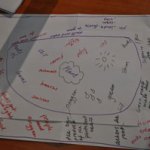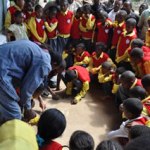27 February 2012
post by Robert Price

Collaborative Networking
 between us in pairs, groups, schools, and global networks
between us in pairs, groups, schools, and global networks
Collaborative Networking is one of Thinking Schools Ethiopia’s Six Starting Points of Thinking which includes reflective questioning; thinking skills; visual mapping; collaborative networking; developing dispositions; and structuring environment. This blog posting will explore Collaborative Networking.
The techniques for cooperative learning are many and there are many models for establishing collaborative groups, classrooms and schools. The research on cooperative learning in school and the need for high quality collaborative groups in the work place connect to the recent evolution of social networking through new technologies as learners engage other learners around the globe. Collaborative Networking (i.e. collaborative learning at all levels) can greatly change the success of students, educators and the community as thinkers and learners. It is sustainable and a low cost high impact methodology – a transformative design. Like all implementations aiming for sustainable success: whole school implementation with a goal of mastery is important if not vital. In this post we’ll briefly look at collaborative networking from within the classroom to whole school to global including:
- Collaborative Learning – Students
- Collegial Coaching – Teachers and School Leaders
- Professional Learning Communities
- Collaborative Learning between Schools Regionally and with Country
- Collaborative Learning between Schools Globally
- Methods
- Tools
 Collaborative Learning – Students
Collaborative Learning – Students
Peer to Peer sharing and learning
Collaborative learning is an environment in which two or more people learn or attempt to learn something together. People engaged in collaborative learning capitalize on one another’s resources and skills:
- asking one another for information,
- evaluating one another’s ideas,
- monitoring one another’s work,
- learning from each other’s prior knowledge – schema,
- etc.
Collaborative learning is based on the model that knowledge can be created within a population where members actively interact by sharing experiences. Several examples of many that are very effective include Think-Pair-Share; Three-Step Interview and Learning Teams (one page outline – pdf file). Visual Mapping and Reflective Questioning are very effective elements to use within cooperative learning.
An example excerpted from a chapter on the Thinking Schools Ethiopia project in an upcoming book on Thinking from Corwin Press models the potential of collaborative learning on a global level:
- A vivid example of the potential this had for our collaborative effort occurred during my fifth visit to Ethiopia when students at Children’s Home Academy were using a laptop in their garden to Skype with a school in North Carolina, USA. The students in Ethiopia were in the student’s garden – one of five at the Children’s Home Academy that provides food for the student lunches. The North Carolina students were tethered to the classroom computer talking about a garden they were envisioning. It was apparent that the food movement in the USA has much to share with and also learn from locations in parts of the world that actually need to have school gardens.
Collaborative learning methodologies can support the development of increasingly complex types of thinking. Benjamin Bloom developed a hierarchy of six types of thinking which become increasingly complex and demanding. Though the “levels” have increasing complexity, at any age level or at any time within a classroom context a teacher or student may move between different levels. There is no linear sequence required for use of this taxonomy. The six levels (as revised by Andersen)
- creating
- evaluating
- analyzing
- applying
- understanding
- remembering
Collegial Coaching – Teachers and School Leaders
Pedagogy
Collegial Coaching is a model that improves teaching — especially performance (i.e. pedagogy) — by observing, learning, and coaching each other within our learning community. Successful Collegial Coaching includes:
- openness to observe and learn as professional colleagues;
- creating systems of observation and learning;
- using techniques that provide a means to learn from each other regularly.
Collegial Coaching includes regular collaborative coaching, discussion groups, and practicing collaboratively in real classroom environments.
 Observation techniques should be clear with goals and techniques to support our collaborative learning. We use techniques based on research to fully develop our abilities as focused observers. An example might be deciding on a specific focus to observe for (e.g. a specific student behavior) then while observing writing and sketching observations + questions. We all bring skills to learn from — new and veteran teachers. By honoring, and pooling our varied and collective talents, the goal of providing the best possible learning environment(s) for students reaches new heights. The Instructional Coaching model initially includes coaching support from outside sources, but ultimately our greatest resources are peer to peer within our teaching and learning community.
Observation techniques should be clear with goals and techniques to support our collaborative learning. We use techniques based on research to fully develop our abilities as focused observers. An example might be deciding on a specific focus to observe for (e.g. a specific student behavior) then while observing writing and sketching observations + questions. We all bring skills to learn from — new and veteran teachers. By honoring, and pooling our varied and collective talents, the goal of providing the best possible learning environment(s) for students reaches new heights. The Instructional Coaching model initially includes coaching support from outside sources, but ultimately our greatest resources are peer to peer within our teaching and learning community.
An example of one Collegial Coaching Model usually in small groups (3-4 best) where the educators regularly observe each other. The model includes:
- The Briefing – The participants initially meet to provide an overview of the lesson and determine the observation focus. It is best to select a facilitator for these sessions. The briefing format includes:
- The Lesson – The lesson will provide an opportunity to observe strategies and techniques that interest all the participants. The lesson format includes:
- The Debriefing – The teachers will meet immediately after the lesson to share observations. It should involve all participants including the teacher leading the lesson.
 Professional Learning Communities
Professional Learning Communities
Within Schools—Between Schools
A professional learning community (PLC) is an extended learning opportunity to foster collaborative learning among colleagues within a particular work environment or field. It is often used in schools as a way to organize teachers into working groups.
Collaborative Learning between Schools
Locally, Regionally, Country, Globally
The methods used by students and educators in a classroom, within a school and local area can be expanded further – including within a region, country and globally. There are many technology tools to support such expanded collaborations – especially when the collaborative learning methodologies are solidly grounded and implemented initially on a local level.
Methods
While ALL six starting points of thinking are relevant and integrative with Collaborative Networking Visual Tools, Reflective Questioning, Structuring Environment are very instrumental in building success. Additionally, Community Building Exercises can be a very effective method of building understanding and respect of the collaborating people.



























 Schools in Norway and Northern Ireland are engaged in a
Schools in Norway and Northern Ireland are engaged in a 





 “This thinking process is a day to day activity with each individual [in all classrooms]. When applied in a government school, the people that come from different backgrounds will learn more. This training is very important to be practiced at all levels in government schools across the grades and all subjects. I suggest it is better to select a model school in different regions. In time these techniques will duplicate to all schools in the country.”
“This thinking process is a day to day activity with each individual [in all classrooms]. When applied in a government school, the people that come from different backgrounds will learn more. This training is very important to be practiced at all levels in government schools across the grades and all subjects. I suggest it is better to select a model school in different regions. In time these techniques will duplicate to all schools in the country.” Tilahun Teshome – Ministry of Education
Tilahun Teshome – Ministry of Education





























